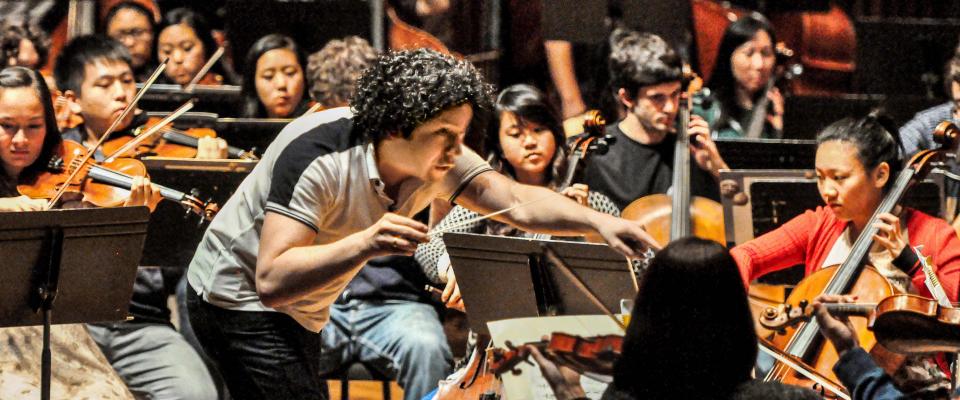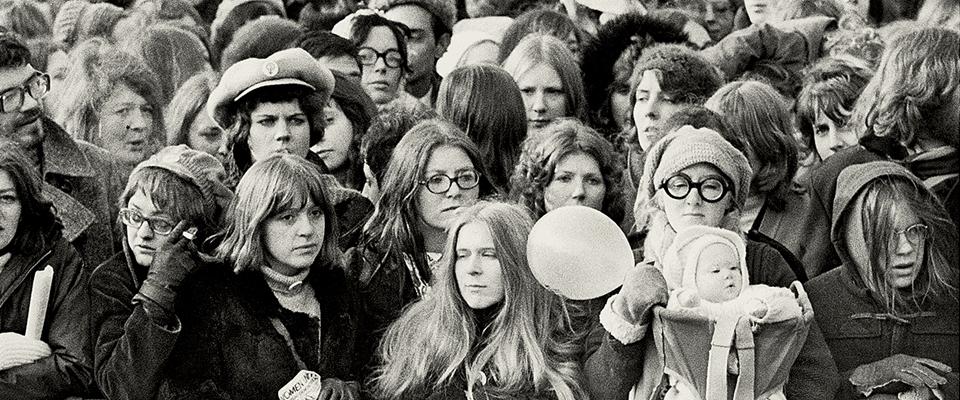Venezuela’s Gustavo Dudamel, conductor of two international orchestras at just 34 years old, is often called the poster child for how early exposure to music and the arts can nourish and lift one toward a better life. Growing up with musician parents likely helped shape his career path, but Dudamel credits much of his success to El Sistema, a Venezuelan program started in 1975 that offers musical access to all.
At this point, El Sistema has nurtured a half-million young musicians, many of whom come from the lower and middle classes. In a 2009 ted talk, founder Jose Antonio Abreu said, “From the minute a child’s taught how to play an instrument, he’s no longer poor…. [M]usic is the number-one prevention against prostitution, violence, bad habits, and everything degrading in the life of a child.”
That may be overstating the case, and critics of the program say it’s restrictive and not a good use of resources, and point to its founder’s ties to the oppressive Hugo Chavez regime. But in study after study, we are shown the great benefits of the arts—especially music. Music therapy is nothing new, and more and more scientific evidence supports other anecdotal benefits that are passed around in social media. In fact, the origins of Cal Performances date from 1906, when stage actress Sarah Bernhardt gave the inaugural performance at the Greek Theatre to help “rebuild public morale after the earthquake and fire” earlier that year.
“… RADICAL is a commitment to bringing together the great artists and thinkers of the world, and a commitment to artistic literacy, which is our key value.”
UC Berkeley RADICAL (Research and Development Initiative in Creativity, Arts, and Learning) is a new Cal Performances program that aims to promote artistic literacy and create cultural access, not just for the usual audiences, but for underserved groups and the digital generations. It will inject new energy into the longstanding SchoolTime Performances program for local K–12 kids, which will evolve from traditional field-trip performances to participatory events. New features include classroom visits and hands-on practice in the art form, as well as training for the classroom teachers.
Asked how the idea for RADICAL came about, Cal Performances executive and artistic director Matías Tarnopolsky said that it comes entirely from a place of music. “It’s what we’re always thinking about—all kinds of music. … RADICAL is a commitment to bringing together the great artists and thinkers of the world, and a commitment to artistic literacy, which is our key value.”
It seems only fitting then that Dudamel, himself both champion and product of early artistic literacy, has been named to the inaugural Berkeley RADICAL four-day orchestral residency.
Dudamel first stepped to the podium as a 12-year-old in his hometown of Barquisimeto during a rehearsal when the conductor hadn’t shown up. Though unprepared, he thought he’d give conducting a try and, after his friends had a few laughs, they got to work. The late-arriving conductor was so impressed that he assigned Dudamel to conduct their next concert. Several months later, Dudamel was named assistant conductor there.
Today, as music director for the past 16 years of the Simón Bolívar Symphony Orchestra of Venezuela, Dudamel takes no fees and ensures that guest musicians from other countries also donate their time. In his other post as music director of the Los Angeles Philharmonic since 2009, Dudamel has brought music to more than 600 children from underserved communities who have benefited from Youth Orchestra LA (yola), one of many programs across the United States influenced or inspired by El Sistema. Dudamel also commits about 25 weeks per year working with El Sistema’s orchestras and children in his home country.
Here in America, however, music has long been supported by wealthy benefactors—and that is equally true for El Sistema USA (ESUSA), a network of more than 100 youth music programs inspired by and dedicated to the original organization’s ideals of equal access and social change through music performance. Several operate under major American orchestras, such as in LA and Baltimore. Others, such as Play On, Philly!, rely on donations and partnerships to sustain them.
Because Cal Performances is a self-sustaining entity (for the 2014–15 school year, only 2.8 percent of the budget was campus supported; the rest comes from grants and donations), new programs like Berkeley RADICAL require an extra boost of funding. To develop the concept, pilot funding was provided by longtime arts supporters Ann and Gordon Getty (Gordon himself is a composer). The residency by Dudamel and the Simón Bolívar Symphony Orchestra is underwritten by the generous Jan Shrem and Maria Manetti Shrem.

Tarnopolsky said that the new initiative would also build on a program (supported by the Andrew W. Mellon Foundation) that creates full-credit Berkeley courses based on or inspired by presentations at Cal Performances. Last spring the business school offered a course exploring collective behavior in work settings that had students attending four performances, including the Alvin Ailey American Dance Theater and St. Paul Chamber Orchestra.
Tarnopolsky said he hopes to knit the performance hall into the life of the campus and community and to promote the idea that artistic literacy is “as essential as any other literacy, including reading, writing, and arithmetic.”
Dudamel and members of the Simón Bolívar Symphony Orchestra will lead master classes and rehearsals that will be open to Bay Area music students. A half-dozen local ESUSA programs will rehearse and perform with the orchestra in the first-ever Seminario on the Berkeley campus, in which, regardless of age or experience, musicians engage together in musical activity. Then Maestro Dudamel will serve up his beloved Beethoven in two performances with the Simon Bolivar Symphony Orchestra: Symphonies Nos. 7 and 8 on September 24; and Symphony No. 9, which will be webcast live from the Greek on September 25.
The four RADICAL Berkeley course offerings for the current school year will be in the Comparative Literature, English, Environmental Design, and Music departments. They include The Art in Artifice, with attendance at a Twyla Tharp performance; Thinking Through Art + Design, tied to performances by the St. Louis Symphony and Cloud Gate Dance Theater of Taiwan, among others; and Graphic Poetics, which will take students to the symphony and several other performances.
Integrating these performances into the University’s research and educational endeavors is a new direction for Berkeley and is key to the RADICAL concept. Cal Performances board chair Gail Rubinfeld said the organization is poised to emerge as a center of innovation and multicultural art, “embracing the diversity and internationalism of our immediate community.”
A study by Partners for Livable Communities and the MetLife Foundation found that immigrants attended only half as many formal cultural events as did residents born in this country. More than half of those queried in a survey of 300 immigrants (of various backgrounds) in Silicon Valley answered yes to whether they considered themselves artists. Does this mean immigrants are overlooked as a potential audience? Perhaps, and perhaps not—if a performer from their home country is touring locally, immigrants attend in numbers, because they’re marketed to directly.
In another study of Latino arts and cultural participation, many Latinos “felt they were not often marketed to, and when they were, they were seen as a monolithic Mexican market, rather than as modern consumers who reflect the cultures of many Latin countries in addition to Mexico.”
Tarnopolsky says that audiences here are already quite diverse, even though shows from a given culture tend to attract members of that culture. On one occasion, he had to make a curtain announcement for a mariachi performance. After addressing the audience in English, the Argentina-born Tarnopolsky repeated it in Spanish and the audience went crazy. No matter their origin, “we are always trying to bring the best of the performing arts,” he says. “We try to follow audience tastes, as well as to lead audience tastes on voyages of new discovery.”
Building new audiences, diverse in race, ethnicity, and age, is a challenge that all arts organizations share. Cal Performances is among the recipients of a grant from the Wallace Foundation’s Building Audiences for Sustainability, which aims to develop new ways to build audiences and study the results. Wallace Foundation plans to share what works in a series of public reports. Cal Performances plans to use Wallace funding to attract recently graduated young professionals.
Outside the classroom, the first public program that kicks off RADICAL is a film by Jamie Bernstein (yes, Leonard’s daughter) and Elizabeth Kling, who both will participate in a panel discussion following the screening. Crescendo: The Power of Music takes an in-depth look at the influence of an ESUSA program on three youngsters in West Philadelphia and Harlem.
Additional Berkeley RADICAL events that are open to the public fuse unusual topics with music and dance. “The Natural World” will celebrate the centenary of the National Parks System via a collaboration between the St. Louis Symphony and photographer Deborah O’Grady. The “ReVisions” series is about modern life and technology and turns our attention to new works, including the Rude Mechanicals’ latest theater work Stop Hitting Yourself and the work of dancemaker Trajal Harrell; it also shines a spotlight on artists who are contemporizing great works of the past. “Zellerbach” will offer Bach experiences through the lens of choreographers, filmmakers, and arrangers in new works of art.
Berkeley RADICAL plans to harvest exclusive video and audio content from the intensive four-day residency and release it on a variety of digital platforms, including a new Cal Performances iTunes “boutique,” where it could distribute performance-related music or podcasts. (Final details were still being worked out at press time.) A short documentary exploring the paths Cal Performances took to encourage engagement with Beethoven and a podcast of his music in performance will also be available on iTunes within a month of the residency.
Of course social media will have its role in RADICAL. Surely you’ve heard about pop-up stores and restaurants? Cal Performances will send social media announcements (Twitter @calperformances) shortly before Whimsical pop-up performances by ensembles of the orchestra on campus and around Berkeley.
Back in 2010, Tarnopolsky’s much-lauded first season at Cal Performances included hints of what’s on deck with this new RADICAL programming, from the orchestral residency to weaving performance into curriculum. “Very different from the usual or traditional” is the definition of “radical.” Could it be that the radical here is the man behind the scenes?
Naheed Attari is a freelance copyeditor and a soprano in the San Francisco Symphony Chorus who plans to sneak into the chorus for Ode to Joy at the Greek.
From the Fall 2015 Questions of Race issue of California.





















